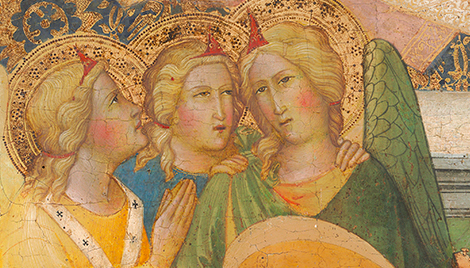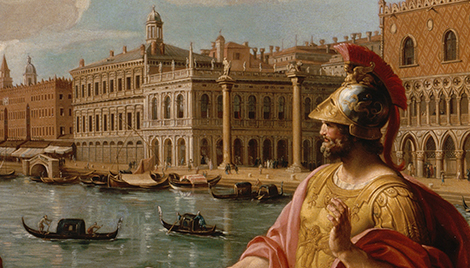Triumph of Fame [The Triumphs of Fame, Time and Divinity]
Triumph of Fame [The Triumphs of Fame, Time and Divinity]
- Artist
- Attributed to Girolamo da Cremona
- Artist Dates
- active c. 1451-1483
- Artist Nationality
- Italian
- Title
- Triumph of Fame [The Triumphs of Fame, Time and Divinity]
- Date
- about 1460s
- Medium
- tempera and oil on panel
- Dimensions
- 52.1 x 54 cm (20-1/2 x 21-1/4 in)
- K Number
- K14
- Repository
- Denver Art Museum
- Accession Number
- 1961.169.2
- Notes
-
One of 6 panels depicting Triumphs at the Denver Art Museum. The series includes K10, K11, K12, K13, K14 and K15.
Provenance
Possibly Gonzaga Collection, Mantua; by 1880 with the Colloredo Mels Family, Castello, Colloredo di Monte Albano, Udine. [1] (Professor Luigi Grassi [1858-1937], Rome); acquired 1905 by the Alte Pinakothek, Munich, until c. 1924. [2] (Paul Drey, New York); sold 1928 to Samuel H.Kress [1863-1955]; gift to the National Gallery of Art in 1939; deaccessioned in 1952 and returned to the Samuel H. Kress Foundation in 1954; gift to Denver Art Museum, no. 1961.169.2. [1] Believed to have been acquired when the Mels family bought a Gonzaga palace in Mantua. [2] Acquisition date and source according to Katalog der Kgl. Älteren Pinakothek in München, 1908, pp. 216-217, nos. 1022b-g.
Catalogue Entry
Attributed to Girolamo da Cremona
Triumph of Fame [The Triumphs of Fame, Time and Divinity]
K14
Denver, Colo., Denver Art Museum (E-IT-18-XVI-940 A, B, C, and 941 A, B, C), since 1954.(1) Wood. K10, 20 1/2 X 213/8 in. (52.1 X 54.3 cm.); K11, 20 3/8 x 21 3/8 in. (51.8 X 54.3 cm.); K12, 20 3/8 x 21 3/8 in. (51.8 X 54.3 cm.); K13, 20 X 21 1/4 in. (50.8 X 54 cm.); K14, 20 1/2 X 21 1/4 in. (52.1 X 54 cm.); K15, 20 5/8 x 21 3/8 in. (52.4 X 54.3 cm.). All in fair condition; few restorations around edges. From their first publication, in 1880,(2) these six panels have been studied in connection with (1) Petrarch's poem, the Triumphs, (2) six Mantegnesque ivory cassonireliefs in Graz, and (3) pictures of the Triumphs of Petrarch described in a letter of 1501 as painted by Mantegna, for part of a Mantuan theater decoration, another part of which consisted of Mantegna's Triumph of Caesar, now at Hampton Court.(3) The connection of K10-15 with Petrarch's Triumphs(4) is obvious, since the painter has followed the poet faithfully in many details. The Graz reliefs(5) decorate two chests from a Gonzaga trousseau of 1477; their analogy with K10-15 suggests that the latter also may have decorated the fronts of two chests, or cassoni, three scenes on each, arranged in the same order as in Petrarch's poem, i.e., as listed at the head of this catalogue note. The now-lost theater decorations mentioned in the letter of 1501 may have furnished the models for K10-15. Some of these panels are better preserved than others, but their execution is fairly uniform. Attributions of the series to Francesco Mantegna, Benaglio, and Bonsignori, and others have been suggested.(6) Of these, Benaglio, perhaps the most likely candidate, would put the work in the Veronese school of Mantegna. Provenance: Castello di Colloredo, near Udine, Italy, as early as 1880.7 Professor Luigi Grassi, Florence. Alte Pinakothek, Munich, 1905-24. Viscount Lee of Fareham (only two, K13 and 12, the Triumph of Love and Triumph of Chastity), 1926.8 Contini Bonacossi, Rome (K10-13, 15). Drey's, New York (K14). Kress acquisition, 1927 (K10-13, 15), and 1928 (K14) – exhibited: Metropolitan Museum of Art, New York, after 1927 (K15), and after 1930 (K10-14; National Gallery of Art, Washington, D.C. (121-126), 1941-54.9
References
(1) Catalogue by W. E. Suida, 1954, pp. 38 ff., and Deliver Art Museum, Guide to the Collection, 1965, pp. 40 f, as pupil of Mantegna. (2) J. Wastler, in Zeitschrift für Bildende Kunst, vol. xv, 1880, pp. 61 ff (3) For the letter see P. Kristeller, Andrea Mantegna, 1902, p. 568. The description seems to locate the Petrarch scenes around the parapet of the stage, with, above, 'richly gilded candelabra.' Possibly the latter are recalled by the simulated candelabra, richly designed and gilded, which separate the scenes in K10-15. (4) Francesco Petrarca, The Sonnets, Triumphs, and Other Poems, 1859, pp. 322 ff. (5) Reproduced by A. Venturi, Storia dell'arte italiana, vol. VII, pt. III, 1914, pp. 215 ff., where K10-15 also are mentioned. (6) Wastler (loc. cit. in note 2, above) thought K10-K15 might be studies for the theater decorations and that both the studies and the theater paintings were by Mantegna's son Francesco, the attribution given also in the Munich catalogue of 1908, pp. 216 f, changed in the 1911 ed. to Veronese miniaturist, C. 1500, and in some editions to Bonsignori. Kristeller (pp. 298 f. n. of op. cit. in note 3, above) tentatively suggests a pupil of Jacopo Bellini. G. Bernardini (in Rassegna d'Arte. vol. XI, 1911. pp. 39 ff.) attributes the panels to Bonsignori, a suggestion tentatively accepted by P. Schubring (Cassoni. 1925, pp. 155, 358). F. Knapp (Andrea Mantegna, 1910, pp. 166 ff.) cites them as of Mantegna's school or copies after him. B. Berenson (in ms. opinion) suggests Parenzano or Montagnana. E. Sandberg-Vavala (in Art i1l America, vol. XXI, 1933, p. 63 n. 17) tentatively suggests Benaglio. R. Longhi, F. M. Perkins (in ms. opinions), and G. Fiocco (Mantegna, 1937, p. 61) attribute the panels to the school of Mantegna (see also note 1, above); while they are classified as North Italian, c. 1500, by T. Dorenius (catalogue of the Viscount Lee Collection, vol. II, 1926, pp. 82 f); and G. Carandente (I Trionfi nel primo rinascimento, 1963, pp. 94 f) gives them tentatively to Niccolo da Verona. (7) Wastler (loc. cit. in note 2, above) says the panels had been in the Colloredo family for generations and were believed to have been acquired when the family bought a Gonzaga palace in Mantua. (8) See reference to Borenius' Lee catalogue in note 6, above. (9) Preliminary Catalogue, 1941, pp. 123 f., as school of Mantegna.




![Triumph of Fame [The Triumphs of Fame, Time and Divinity]](https://bmmweb.blob.core.windows.net/kress/300/4_all_at_transparency.jpg)

![Triumph of Fame [The Triumphs of Fame, Time and Divinity]](https://bmmweb.blob.core.windows.net/kress/300/1_iiif_k14_at_transparency.jpg)
![Triumph of Fame [The Triumphs of Fame, Time and Divinity]](https://bmmweb.blob.core.windows.net/kress/300/2_iiif_k14_cs_transparency.jpg)
![Triumph of Fame [The Triumphs of Fame, Time and Divinity]](https://bmmweb.blob.core.windows.net/kress/300/3_k14_bt_transparency.jpg)
![Triumph of Fame [The Triumphs of Fame, Time and Divinity]](https://bmmweb.blob.core.windows.net/kress/80/4_all_at_transparency.jpg)
![Triumph of Fame [The Triumphs of Fame, Time and Divinity]](https://bmmweb.blob.core.windows.net/kress/80/1_iiif_k14_at_transparency.jpg)
![Triumph of Fame [The Triumphs of Fame, Time and Divinity]](https://bmmweb.blob.core.windows.net/kress/80/2_iiif_k14_cs_transparency.jpg)
![Triumph of Fame [The Triumphs of Fame, Time and Divinity]](https://bmmweb.blob.core.windows.net/kress/80/3_k14_bt_transparency.jpg)